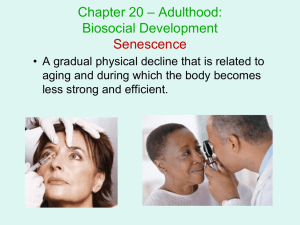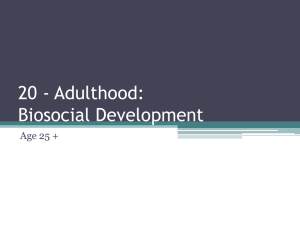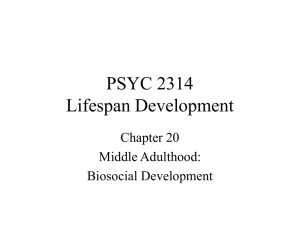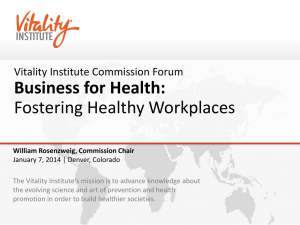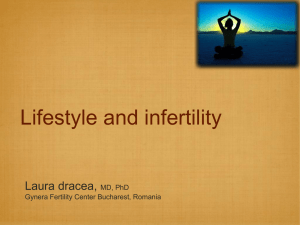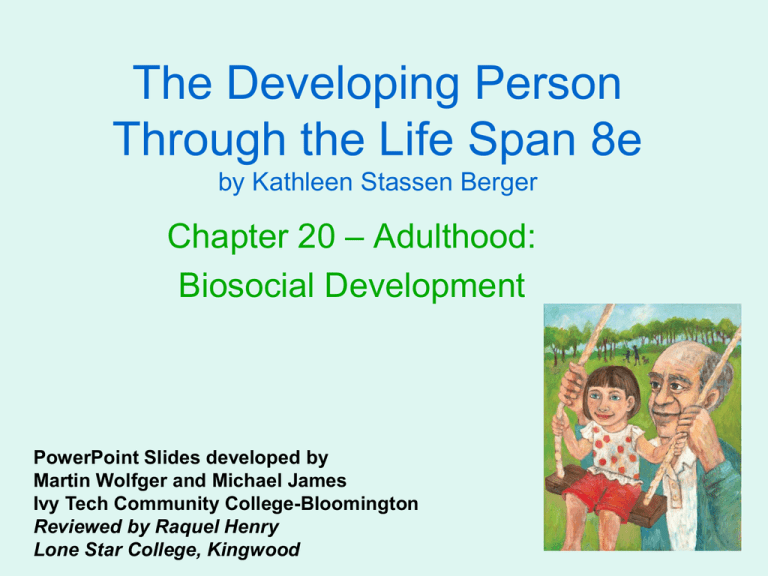
The Developing Person
Through the Life Span 8e
by Kathleen Stassen Berger
Chapter 20 – Adulthood:
Biosocial Development
PowerPoint Slides developed by
Martin Wolfger and Michael James
Ivy Tech Community College-Bloomington
Reviewed by Raquel Henry
Lone Star College, Kingwood
Senescence
• A gradual physical decline that is related to
aging and during which the body becomes
less strong and efficient.
The Aging Brain
• Neurons fire more slowly, messages sent from
the axon of one neuron are not picked up as
quickly by the dendrite of another neuron,
reaction time lengthens
• Brain size decreases, multitasking gets harder,
processing takes longer
• Complex working memory tasks may become
impossible
The Aging Brain
Severe brain loss in middle age is usually
due to:
• Drug abuse
• Poor circulation
• Viruses
• Genes
Physical Appearance
• Collagen decreases by about 1% per year
• By age 30: Skin is becoming thinner and less
flexible; wrinkles become visible
• By age 60: All faces are wrinkled
• Hair turns gray and gets thinner
• “Middle-age spread” appears
• Muscles weaken
• Height decreases by late middle age
• Many changes occur more slowly in people who
exercise.
Sense Organs
Vision
– Peripheral vision narrows faster than frontal vision
– Color vision shifts from vivid to faded more quickly
than does black and white
– Nearsightedness: Increases gradually beginning in
one’s 20s.
– Farsightedness: Lens of the eye is less elastic and
the cornea flattens by middle age.
– Younger adults are usually either nearsighted or
farsighted; most older adults are both
Vision
Hearing
Presbycusis
• A loss of hearing that is associated with
senescence and that usually does not
become apparent until after age 60
The Sexual-Reproductive System
Sexual responsiveness
• Sexual arousal occurs more slowly with age and
orgasm takes longer.
• Distress at slower responsiveness is more associated
with anxiety, interpersonal relationships, and
expectations than with aging itself.
• Study Findings:
- Adults of all ages enjoy “very high levels of emotional
satisfaction and physical pleasure from sex within their
relationships.”
- Men and women were most likely to be “extremely
satisfied” with sex if in a committed, monogamous
relationship.
Sexual Responsiveness
Fertility
• Infertility is most common in nations where
medical care is scarce and STIs are common.
• United States: 15% of all couples are infertile
– Partly because many postpone childbearing
– Half of those trying to conceive in their 40s are
infertile and the other half risk various
complications
Causes of Infertility
In males:
– Multiple factors (e.g. advanced age, fever, radiation,
prescription drugs, stress, environmental toxins, drug
abuse, alcoholism, cigarette smoking) can reduce
sperm number, shape, and motility.
In females:
– Fertility can be affected by anything that impairs
physical functioning (e.g. advanced age, diseases,
smoking, extreme dieting, obesity).
– Pelvic inflammatory disease can block the fallopian
tubes, preventing sperm from reaching an ovum.
Fertility Treatments
• Assisted Reproductive Technology (ART)
– Advances in medicine have solved about half of all
fertility problems.
– Overcomes obstacles such as a low sperm count and
blocked fallopian tubes.
• In vitro fertilization (IVF)
– Procedure in which ova (egg cells) are surgically
removed from a woman and fertilized with sperm in a
laboratory.
– After the fertilized cells (the zygotes) have divided
several times, they are inserted into the woman’s
uterus
Menopause
• Menopause
– Time in middle age (around age 50) when a woman’s
menstrual periods cease completely and the production of
estrogen, progesterone, and testosterone drops
considerably.
– Dated to one year after a woman’s last menstrual period.
• Hormone replacement therapy (HRT)
– Treatment to compensate for hormone reduction at
menopause or after removal of the ovaries.
– Usually involves estrogen and progesterone
– Minimizes menopausal symptoms and diminishes the risk
of osteoporosis in later adulthood.
– Involves health risks.
Men in Middle Age
Andropause (male menopause)
• Coined to signify a drop in
testosterone levels in older men,
resulting in a reduction in sexual
desire, erections, and muscle
mass.
• Effectiveness of HRT is
questionable.
Health Habits and Age
Drug Abuse
• Abuse of illegal drugs decreases markedly over
adulthood.
• Marijuana use is slowest to decline.
– In the U.S., 8% of 24-34 year olds still use it,
impairing cognition and oral health.
• Abuse of prescribed drugs increases in
adulthood.
Health Habits and Age
Tobacco
• Cigarette smoking has declined in the U.S.
over the past 50 years.
• Worldwide trends are less encouraging.
• Smoking rates rising in developing nations.
• Smoking-related cancers increasing throughout the
world.
• Variations among nations, cohorts, and
gender indicate smoking is affected by social
norms, laws, and advertising.
Tobacco
Alcohol Abuse
Drinking in moderation
• No more than two drinks a day increases life
expectancy.
• Alcohol reduces coronary heart disease and
strokes.
• Increases “good” cholesterol and reduces
“bad” cholesterol.
• Lowers blood pressure.
Alcohol Abuse
Heavy Drinking
• Increases the risk of violent death and is implicated in
60 diseases.
• Stark international variations in alcohol abuse.
• Binge drinking signals a problem
– About 20% of U.S. adults had five or more drinks on a
single occasion in the past year.
• Disproportionate burden of harm in poorer countries
– Prevention and treatment strategies have not been fully
established.
Health Habits and Age
Overeating
• Many adults choose high-calorie, low-nutrient foods.
• Only 27% of U.S. adults eat three daily servings of
vegetables.
• Too many high-calorie foods combined with too little
activity leads to obesity.
• Excess weight increases the risk of every chronic
disease (e.g. diabetes).
Health Habits and Age
United States Facts:
• Highest rates of obesity and diabetes
• 66% of U.S. adults are overweight
– Of those, 50% are obese and 5% morbidly obese
• Metabolism decreases by one-third between ages 20
and 60.
• Genetics: Two alleles that correlate with both
diabetes and weight.
• Increase in obesity rates cannot be blamed on genes
cultural influences are more important!
Overeating
Health Habits and Age
Inactivity
• Regular physical activity at every stage of life protects
against serious illness.
• Sitting for long hours correlates with almost every
unhealthy condition.
• Even a little movement helps
– More intense exercise (e.g. swimming, jogging,
bicycling) is ideal.
• Connection between exercise and health is causal:
People who are more fit are likely to resist disease
and feel healthier as they age.
Accumulating Stressors
• Stressor
– Any situation, event, experience, or other
stimulus that causes a person to feel
stressed.
• Problem-focused coping
– A strategy to deal with stress by dealing with it
directly.
• Emotion-focused coping
– A strategy to deal with stress by changing
feelings about the stressor.
Accumulating Stressors
• Allostatic load
– The total physiological stress that a person
has
– A high load increases the risk of disease.
• Weathering
– Gradual accumulation of stressors over a long
period of time, wearing down the resilience
and resistance of a person.
Measuring Health
• Most of the U.S. expenditure on health
goes toward preventing death among
people who are already sick.
• Public health
– Measures that help prevent morbidity,
mortality, and disability in the public at large.
i.e. immunization, preventive health practices
Measuring Health
• Mortality
–Death
–Usually refers to the number of deaths each
year per 1,000 members of a given
population.
• Morbidity
–Disease
–Refers to the rate of physical and emotional,
acute (sudden), chronic (ongoing), and fatal
diseases in a given population.
Mortality
Disability and Vitality
• Disability
– Long-term difficulty in performing
normal activities of daily life
because of some physical,
emotional, or mental condition.
• Vitality
– Measure of health that refers to
how healthy and energetic—
physically, emotionally, and
socially—an individual actually
feels.
Disability and Vitality
• Disability-adjusted life years (DALYs)
– A measure of the reduced quality of life
caused by disability.
• Quality-adjusted life years (QALYs)
– Comparing survival without vitality to survival
with good health.
Correlating Income and Health
Money and education affect health in every
nation
• Well-educated, financially secure adults live
longer.
• Suspected reasons:
– Education teaches healthy habits.
– Education leads to higher income, which allows
better housing and medical care.
– Education may be a marker for intelligence, which
is a protective factor.
Correlating Income and Health

